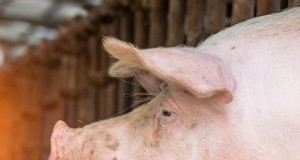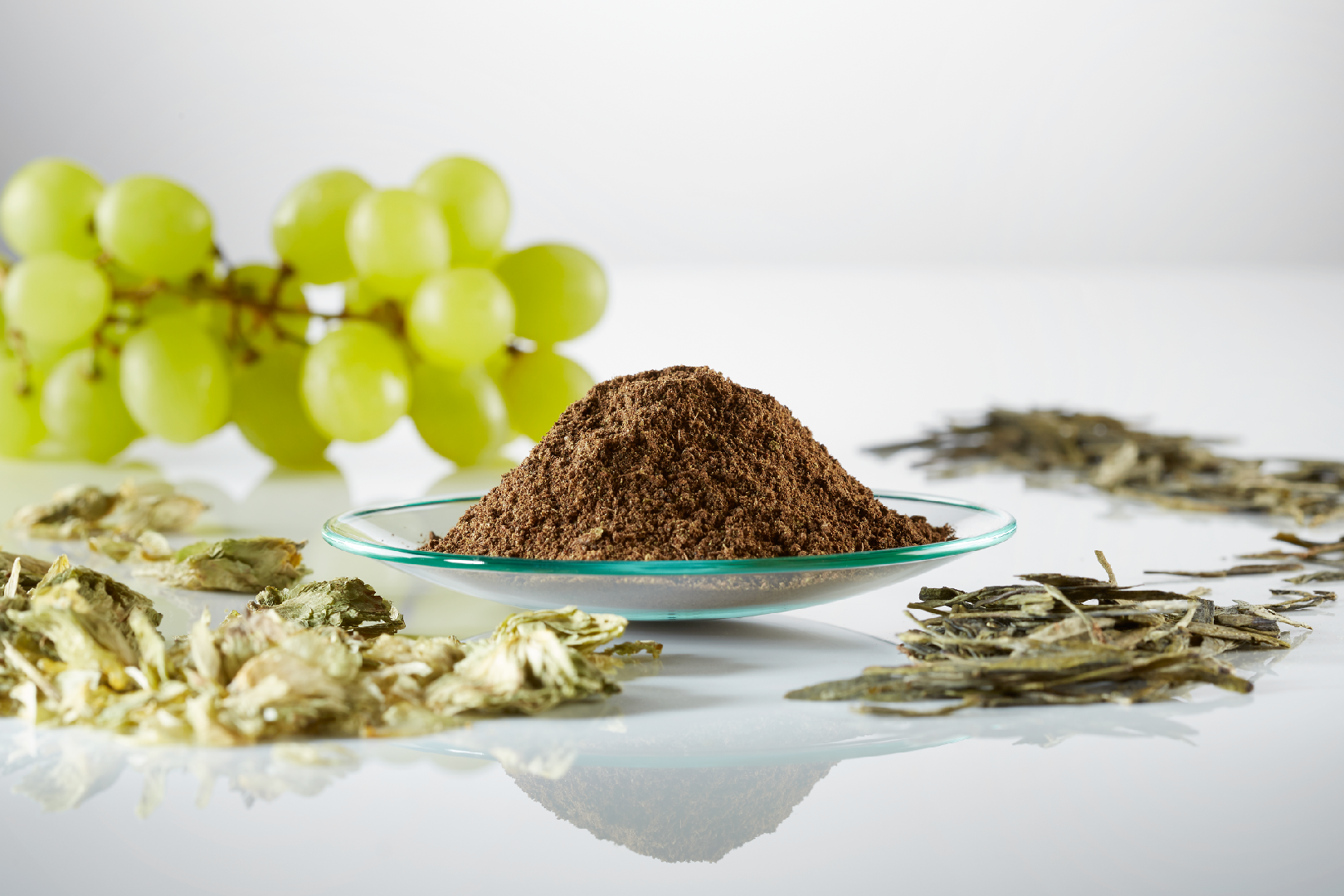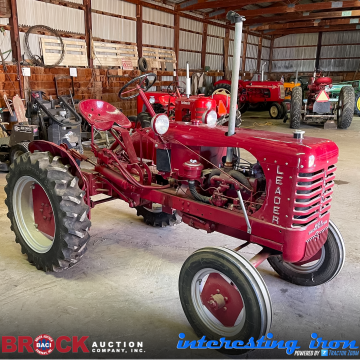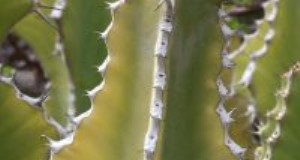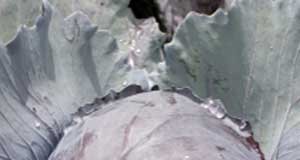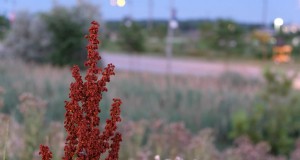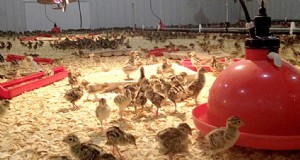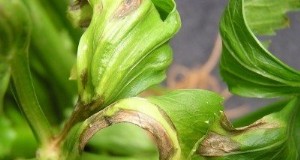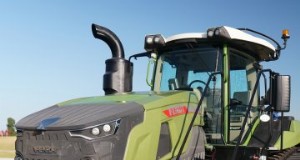INLEIDING TOT DE KRUIDBEHANDELING:
Kruidenteelt:Het kruid is een stof die in voedsel wordt gebruikt voor smaak, kleur of conservering. Verschillende kruiden worden verkregen uit verschillende delen van een plant of boom, zoals zaden, blaft, wortels en vruchten. Van sommige kruiden wordt verwacht dat ze antimicrobiële en antibacteriële eigenschappen hebben. Het gebruik van sommige kruiden komt voor in cosmetica, religieuze rituelen, medicijnen en parfums. Er wordt aangenomen dat verschillende kruiden afkomstig zijn uit verschillende landen van de wereld. Kaneel en zwarte peper zijn afkomstig uit Zuid-Azië en het Midden-Oosten, kruidnagel tijdens de Mesopotamische beschaving, nootmuskaat van de Banda-eilanden in Zuidoost-Azië. De vraag naar specerijen was in de middeleeuwen het grootst in Europa. In deze periode werden specerijen geïmporteerd uit Azië en Afrika. In de moderne tijd was er een grote vraag naar de pepermarkt in India. Het grootste probleem met kruiden tegenwoordig is verdunning. De kwaliteit van de kruiden is inferieur geworden door vervalsing (het mengen van andere ongewenste producten in het oorspronkelijke mengsel).
Verschillende soorten kruiden zijn vers, gedroogd en poeder. Specerijen zijn over het algemeen verkrijgbaar in droge vorm voor een langere bruikbaarheid en een langere houdbaarheid. Er zijn enkele kruiden die bij vers gebruik meer essentie geven dan de gedroogde, zoals gember. Specerijen zoals kurkuma worden altijd in poedervorm gebruikt. Specerijen zoals venkel en mosterd worden zowel in hun geheel als in poedervorm gebruikt. De smaak van een specerij gaat verloren bij blootstelling aan lucht als gevolg van oxidatie en verdamping. Dus, het wordt ten zeerste aanbevolen om de kruiden als geheel te bewaren en indien nodig gemalen om een maximale smaak te ervaren. De kruiden die voor het koken worden gebruikt, worden vroeg tijdens de bereiding toegevoegd, zodat de smaak in het voedsel wordt getrokken, in tegenstelling tot kruiden die aan het einde van de bereiding worden toegevoegd.
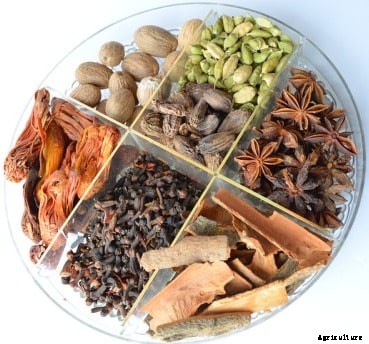 Teeltpraktijken van specerijen.
Teeltpraktijken van specerijen.
Specerijen bevatten naar verwachting calorieën, portie vet, koolhydraten, mineralen, micronutriënten en eiwitten. Komijn en gember vertonen een hoge antioxiderende eigenschap die helpt als natuurlijke conserveermiddelen.
Specerijen zijn besmet met een bacterie die salmonella wordt genoemd. Sommige van deze bacteriën zijn resistent tegen antibiotica en worden nu behandeld met behulp van stralingssterilisatiemethode.
KURKUMA SPICE LANDBOUW:
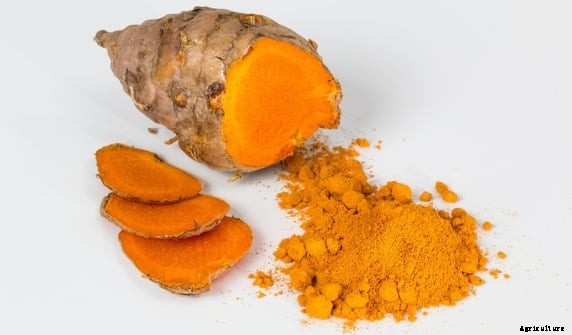 Kurkuma.
Kurkuma. - INVOERING: De binominale naam voor kurkuma is Curcuma longa en behoort tot de gemberfamilie. Het wordt beschouwd als de inwoner van het Indiase subcontinent. Dit is een wortelstok die in droge poedervorm wordt gebruikt. Het heeft geneeskrachtige eigenschappen en wordt daarom gebruikt voor antibacteriële behandelingen. Het is geel van kleur en heeft een lekker aroma.
- BODEM- EN KLIMAATOMSTANDIGHEDEN VOOR DE KURKUMAKRUIDVERWERKING: Voor de teelt van kurkuma worden zandige en kleiachtige leemgronden gebruikt die een rijk humusgehalte hebben en goed gedraineerd zijn. Het wordt gekweekt op zeeniveau of op een hoogte van 1500 m boven zeeniveau. De temperatuur van de regio wordt geschat op 20-30 graden Celsius en het gemiddelde regenval moet ongeveer 1500-2250 mm zijn
- VOORTPLANTING: Kurkuma wordt vermeerderd door wortelstokstekken die in het late winterseizoen worden geplant.
- LAND VOORBEREIDING EN PLANTEN: kuilen van 3 inch diepte worden gemaakt met behulp van een handschoffel en de rijenafstand is 25 cm x 30 cm . Deze zijn bedekt met aarde en droge rundermest. Ruggen en voren bevinden zich op a afstand van 45-60 cm tussen rijen en op een onderlinge afstand van 25 cm voor planten.
- MEST EN IRRIGATIE: Veemest van 40 ton/ha wordt veel gebruikt voor de kurkumateelt. Aangezien deze plant van het type irrigatie is, het heeft nodig 15-20 cycli voor zware grond en 35-40 cycli voor lichte gronden. FYM @10 ton/ha is vereist voor basale dressing. het rantsoen van N:P:K is 125:37:37 kg/ha.
- Mulchen doe je twee keer met suikerrietafval of groen vertrekt @ 12-15 ton /ha met een interval van 50 dagen.
- ZIEKTEBEHANDELING: schietboorder wordt bestuurd door: spuiten 0,1% Malathion . Wortelstokschaal wordt gecontroleerd door de wortelstokken vóór het planten in quinalphos 0,1% te dompelen. Wortelrot wordt bestreden met behulp van dithane M-45 0,3% tijdens de voorbereiding van de grond. Bladvlek wordt gecontroleerd door: spuiten 0,2% dithane M-45 .
- OOGSTEN EN VERWERKEN: oogsten gebeurt na 10 maanden na het planten wanneer de wortelstok volwassen wordt. Warm weer is goed voor kurkuma, dus als ze in oktober worden gezaaid, wordt ze in augustus geoogst. Wortelstokken worden gekookt tot ze zacht zijn en ongeveer 15 dagen in de zon gedroogd op bamboematten.
- OPBRENGST: Gemiddeld levert een hectare land 8-10 ton kurkuma op.
BAAIBLAD SPICE LANDBOUW:
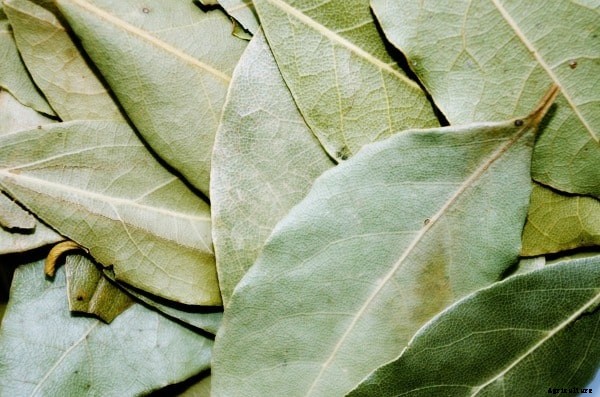 Laurierblad.
Laurierblad. - INVOERING: Laurierblad (binominale naam:Laurus nobilis). Het is ontstaan in de Middellandse Zee en groeit tot een hoogte van 40 voet. De planten hebben middelgrote groene bladeren. Het wordt zowel als smaakstof als medicijn gebruikt.
- BODEM- EN KLIMAATOMSTANDIGHEDEN VOOR DE LANDBOUW VAN laurierblaadjes: Zonlicht is een vereiste en koude wind of vorst kan schadelijk zijn. Het gunstige klimaat is een warm en vochtig mediterraan klimaat. Goed doorlatende grond met voldoende organische stof is zeer geschikt met een pH-bereik van 6-8.
- VOORTPLANTING: Gelaagde scheuten of wortelstekken worden gebruikt voor de vermeerdering van laurier.
- LAND VOORBEREIDING EN PLANTEN: Het land wordt aangevuld met stalmest en onkruid wordt verwijderd door te ploegen.
- MEST EN IRRIGATIE: Rotte stalmest is nuttig om de bodem rijker te maken. Door middel van druppelirrigatie wordt gezorgd voor voldoende watervoorziening om het bodemvocht intact te houden.
- ZIEKTEBEHANDELING: mijten, bladluizen en harde schubben zijn plagen die de boom infecteren en worden bestreden door de toepassing van neemolie. Zwavelspray voorkomt zwarte vlekken en bladschade.
- OOGSTEN EN VERWERKEN: Omdat het een groenblijvende variëteit is, de bladeren zijn het hele jaar door beschikbaar voor de oogst. Over het algemeen zijn ze droog voor gebruik.
- OPBRENGST: Een hectare land levert 6 ton bladeren op.
NUTMEG EN FACE SPICE LANDBOUW:
- INVOERING: nootmuskaat en foelie zijn producten van dezelfde boom (botanische naam:Myristica fragrans houtt). Deze boom komt oorspronkelijk uit Indonesië en wordt nu in sommige delen van India gekweekt. Het is een groenblijvende boom die dicht bebladerd is en tot 20 meter hoog kan worden. Deze kruiden worden gebruikt in voedselaroma's, parfums, bereiding van oliën en boters.
- BODEM- EN KLIMAATOMSTANDIGHEDEN VOOR NUTMEG SPICE LANDBOUW: warm, vochtig klimaat met een jaarlijkse regenval van 150 cm is vereist voor deze bomen. Het ideale gebied is vanaf zeeniveau tot 1300 m boven zeeniveau. De hellingen van West- en Oost-Ghats zijn een goede keuze voor de nootmuskaat- en foelieteelt. Grond met klei, leem, zand en rood lateriet is geschikt voor deze boom.
- VOORTPLANTING: Het zaad van de vruchten van deze boom wordt gebruikt voor vermeerdering. Luchtlagen en knopvorming zijn ook succesvolle methoden voor vermeerdering, maar de techniek van ‘epicotyle enting’ is het meest productief.
- LAND VOORBEREIDING EN PLANTEN: als de zaailingen groeien, na 12 tot 18 maanden ze worden getransplanteerd naar het hoofdgebied. Kubieke kuilen met een afmeting van 60 cm worden gegraven en gevuld met bovengrond en compost. De afstand tussen de pits is 8 mx 8 m . Het planten gebeurt tijdens het regenseizoen. In de eerste jaren is schaduw nodig. Mulchen gebeurt met afval dat in de omgeving beschikbaar is.
- MEST EN IRRIGATIE: De boom heeft een enorme hoeveelheid mest nodig voor een hogere opbrengst en groei. FYM @ 10 kg/plant wordt het eerste jaar gebruikt. Een boom van 15 jaar oud zou ongeveer 50 kg mest nodig hebben. Stikstof @ 20 gram, fosfor @ 18 gram en potas @ 50 gram worden in het eerste jaar op elke plant toegepast. De dosis neemt toe met de leeftijd van de boom en wordt twee keer per jaar toegediend; Mei-juni en september-oktober. Irrigatie is niet hard nodig.
- ZIEKTEBEHANDELING: Afsterven veroorzaakt door diplodianatalensis wordt gecontroleerd door Bordeaux-mengsel op het uiteinde van takken aan te brengen. Draadlicht wordt veroorzaakt door Marasmius sp. wordt gecontroleerd door 1% van het Bordeaux-mengsel te spuiten. Vruchtrot wordt veroorzaakt door Phytophthora en Diplodia natalensis, die wordt bestreden door sproeien 1% van Bordeaux
- OOGSTEN EN VERWERKEN: Als zaailingen worden gebruikt, begint het lager in 7-8 jaar, maar als het enten is gedaan, begint het dragen binnen 4-5 jaar. De volledige peiling wordt bereikt na 15-20 jaar en levert tot 60 jaar op. Er wordt geoogst van juni tot augustus. Het rijpen van de vrucht is bekend wanneer de vlezige schil openbarst. De foelie wordt gescheiden van de noot en gedurende 10-15 dagen langzaam in de zon gedroogd. Het zaad wordt ook apart gedroogd gedurende 4-8 weken in de zon of door kunstmatige processen. De buitenste schil wordt verwijderd en de moer wordt eruit gehaald.
- OPBRENGST: De gemiddelde opbrengst van een enkele boom is 2000-3000 vruchten per jaar. De verwachting is dat één hectare land 800 kg nootmuskaat en 100 kg foelie kan produceren.
STERANIJS SPICE LANDBOUW:
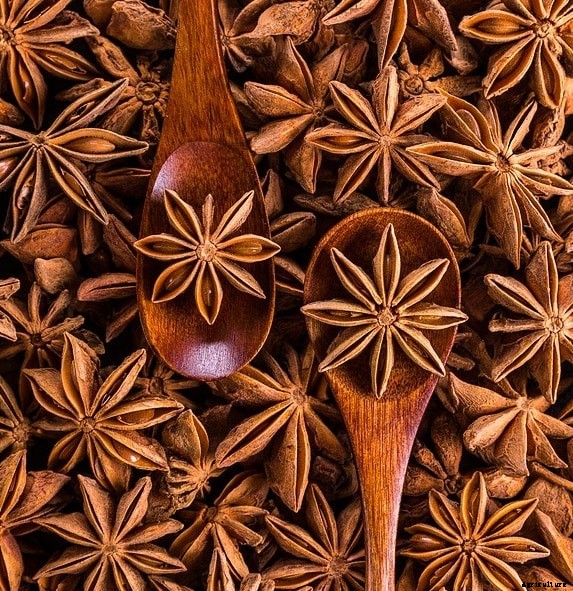 Steranijs.
Steranijs. - INVOERING: Dit kruid dankt zijn naam aan de vorm. De botanische naam is Illicium verum. Siberië wordt als ideaal beschouwd voor de anijsteelt. Dit is een donkerbruin gekleurd kruid met een sterk aroma. Dit wordt ook wel anijszaad genoemd en heeft geneeskrachtige eigenschappen. Het is een groenblijvende boom en wordt 5-10 m hoog.
- BODEM- EN KLIMAATOMSTANDIGHEDEN VOOR DE KWEKERIJ VAN STERANIJS: Voor de anijsteelt is een rijke humusgrond of lichtzure grond het meest geschikt. Vereist een subtropisch klimaat waar de temperatuur niet lager is dan -10 graden Celsius. De plant heeft een warm zonnig klimaat nodig waar geen droge of koude wind is. PH van grond is 6-6,7.
- VOORTPLANTING: Vermeerdering gebeurt door rechtstreeks zaden of stekken te zaaien. De temperatuur voor vermeerdering is 18-20 graden Celsius.
- LAND VOORBEREIDING EN PLANTEN: 6 weken oude zaailingen worden gezaaid met een tussenruimte van 12 inch . Elke rij is gescheiden door 18-24 inch . Het planten gebeurt in het voorjaar.
- MEST EN IRRIGATIE: Voldoende vocht vasthouden is voldoende. In de winter is weinig irrigatie nodig. Het verspreiden van een laag compost van 3 inch rond de boom is de beste meststof. Soms voor een hogere opbrengst en kwaliteit een synthetische NPK-meststof of Bactofil B-10 en slavol (biomeststoffen) worden gebruikt.
- ZIEKTEBEHANDELING: omdat het een antibacteriële en ongediertewerende variëteit is, er is dus niet veel nodig om een ziekte voor deze planten te bestrijden.
- OOGSTEN EN VERWERKEN: De boom heeft 6 jaar nodig om vruchten te dragen wanneer hij uit zaden wordt gekweekt. De vruchten worden rijp geplukt en in de zon gedroogd totdat ze van groen naar roodbruin verkleuren.
- OPBRENGST: Onder gunstige omstandigheden is de gemiddelde vruchtopbrengst van deze boom 1551 kg/ha.
GROTERE KARDEMOM SPICE LANDBOUW:
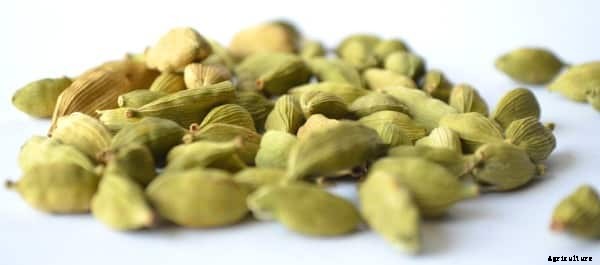 Kardemom.
Kardemom. - INVOERING: Dit wordt ook zwarte kardemom genoemd en de binominale naam is Amomum subulatum. De peulen hebben een sterk rokerig aroma en worden gebruikt als specerij. De grootste producten komen uit Nepal. Het heeft ook medicinale toepassingen, zoals de behandeling van geelzucht.
- BODEM- EN KLIMAATOMSTANDIGHEDEN: Dit kruid wordt op hoogtes van 1000-2000 boven gemiddeld zeeniveau. Het vereist een jaarlijkse gemiddelde regenval van 3000-3500 mm . Diep, goed doorlatende leemachtige grond is goed voor deze planten. De pH van de bodem moet worden gehandhaafd op 4.5-6.
- VOORTPLANTING: Vermeerdering van deze plant gebeurt vegetatief via wortelstokken of door zaden. Wortelstokken van volwassen planten worden genomen en verwerkt tot kleinere bosjes en in kuilen geplant.
- LAND VOORBEREIDING EN PLANTEN: Matige helling voor de landbouw van deze plant wordt overwogen. Putten van afmetingen 30 x 30 x 30 cm worden gegraven met een tussenruimte van 5 x 1,5 m tussen elke put tijdens de moesson. De kuilen zijn bedekt met teelaarde en compost. Zaailingen worden in het midden van de put geplant en het mulchen gebeurt met droge bladeren aan de basis van de plant.
- MEST EN IRRIGATIE: Veemest en niet-eetbare oliekoeken als mest. Een betere irrigatie geeft een hogere opbrengst. Afhankelijk van de behoefte wordt sprinklerirrigatie toegepast.
- ZIEKTEBEHANDELING: In deze plant kunnen schimmel- en bacterieziekten voorkomen. De twee belangrijkste bedreigingen voor deze plant zijn Chirke en Foorkey.
- OOGSTEN EN VERWERKEN: wanneer het zaad van een capsule bruin wordt, de frezen zijn 30-35 cm afgesneden en mogen rijpen voor 10-15 meer Het oogsten wordt gedaan door een apparaat genaamd ' Elaichichurri' en de spikes zijn opgehoopt. De capsules worden gescheiden en gedroogd. De kelk wordt verwijderd door de capsule over een draad te wrijven.
- OPBRENGST: Uit schattingen blijkt dat één hectare land 2000 kg droge kardemom oplevert.
KLEINERE KARDEMOM SPICE LANDBOUW:
- INVOERING: Deze specerij komt oorspronkelijk uit het Indiase subcontinent en is de meest benodigde specerij in de hele lijst. Het is en groenblijvende plant gevonden in de West-Ghats. Binominale naam van deze specerij is Elettaria Cardamomum L. De maximale hoogte van deze plant is 2-4 meter en de in India gevonden variëteiten zijn Mysore, Malabar- en vazhukka-type.
- BODEM- EN KLIMAATOMSTANDIGHEDEN VOOR KARDEMOM SPICE LANDBOUW: De optimale temperatuur en regenval die nodig zijn voor het kweken van minder kardemomkruiden is: een 10-35 graden Celsius en 1500-4000 mm jaarlijkse regenval respectievelijk. Zwarte leembodem met rijke humus, vooral in de bosgordel, is het meest geschikt voor de teelt van deze specerij. Zandgrond heeft helemaal geen voorkeur.
- VOORTPLANTING: Zaden of uitlopers worden gebruikt voor vermeerdering. Deze zaden worden in kwekerijen gekweekt en onder de juiste omstandigheden in het hoofdgebied geplant.
- LAND VOORBEREIDING EN PLANTEN: 45 cm x 45 cm x 30 cm kuilen worden gegraven in april-mei en zijn gevuld met compost en bovengrond. Het planten gebeurt langs de contouren van een helling met een tussenruimte van 2 mx 1 m . Het begin van de moesson is ideaal voor het planten van deze zaden en ze worden in de zomer overgeplant in het hoofdgebied met een tussenruimte van 20cm x20cm . Er is schaduw en er wordt regelmatig water geleverd.
- MEST EN IRRIGATIE: Stikstof @90 gram, fosfor @60 gram en kalium @ 120 gram zijn vereist voor een bedmaat van 5 m x 1 m. Deze dosis wordt geleverd in drie termijnen met een interval van 45 dagen tussen elk. Het gehalte aan kunstmest dat voor dit gewas wordt gebruikt, is: stikstof @ 75 kg, fosfor @75 kg en potas @150 kg per hectare als het wordt geïrrigeerd door externe bronnen, maar als de velden door regen worden geïrrigeerd, is het gebruikte mestrantsoen 30:60:30 kg/ha. De totale bemesting wordt gesplitst en twee keer toegepast:één in mei en één in september. 30 cm rondom de plant worden de meststoffen aangebracht. Irrigatie is zeer vereist tijdens de pluimvorming, bloei en vruchtvorming. Tot de komst van moessonirrigatie wordt gedaan met een interval van 10-15 dagen.
- ZIEKTEBEHANDELING: Tripsen en scheutboorders worden bestreden door monocrotofos 0,025% te sproeien (maart-september). Bladluizen worden bestreden door 0,05% dimethoaat te sproeien. Parasitaire nematoden worden bestreden door de planten te behandelen met carbofuran 3g @ 5kg a.i/ha. Capsulerot wordt bestreden door te sproeien 1% Bordeaux Wortelrot wordt bestreden door de grond te behandelen met 0,2% koperoxychloride .
- OOGSTEN EN VERWERKEN: De planten beginnen al na twee jaar planten vruchten af te werpen. De oogst vindt plaats in oktober-november. De geoogste vruchten worden gedroogd met behulp van een elektrische droger bij een temperatuur van 45-50 graden voor ongeveer 14-18 uur .
- OPBRENGST: Naar schatting levert één hectare land 1300 kg droge kardemom op.
KORIANDER SPICE LANDBOUW:
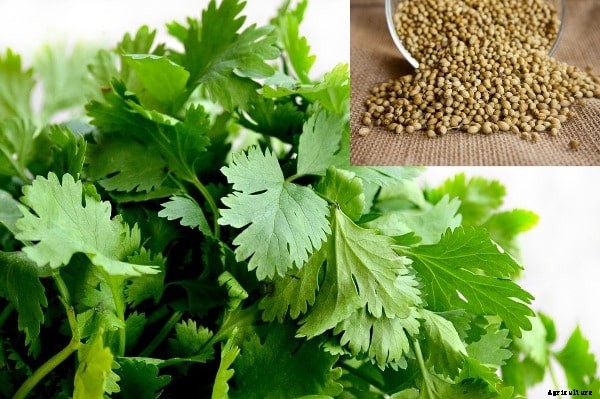 Koriander.
Koriander. - INVOERING: Dit is een kruid afkomstig uit het Middellandse Zeegebied. In India doen sommige staten aan korianderteelt, maar meestal is het voor lokaal gebruik in plaats van voor export. Er wordt weinig geëxporteerd naar andere landen. De binominale naam van deze plant is Coriandrum Sativum L. Het is het meest wenselijk vanwege zijn smaak en aroma. De bladeren van de plant en de gedroogde vruchten worden beide gebruikt bij de bereiding van voedsel. Deze kruidenplanten worden 30-70cm hoog. Het heeft ook enkele medicinale toepassingen.
- BODEM- EN KLIMAATOMSTANDIGHEDEN VOOR DE KWEEK VAN KORIANDERKRUID: Deze plant is het hele jaar door geschikt voor de teelt en is een tropische soort. Elke grondsoort met rijk organisch materiaal is geschikt voor de teelt. Zwarte katoenaarde wordt als het beste beschouwd bij voldoende regenval.
- VOORTPLANTING: Voortplanting gebeurt door middel van zaden.
- LAND VOORBEREIDING EN PLANTEN: Na het begin van de moesson wordt het land 3-4 keer geploegd en aangezien het een Rabi-gewas is, wordt het zaaien van zaden gedaan in oktober en november. Een hectare land nodig 10-15 kg van zaden. Een betere ontkiemingstechniek is om de zaden in water te weken voor 12-24 uur voor het zaaien. Rijen in de boerderij zijn gescheiden door een afstand van 30-40 cm en maximale diepte is 3 cm.
- MEST EN IRRIGATIE : FYM @ 10 ton/ha wordt gebruikt. NPK-meststoffen @ 15 kg, 40kg en 20kg per hectare respectievelijk, voor geïrrigeerde gewassen is vereist, terwijl voor regengevoede gewassen NPK @ 20kg, 30kg, 20kg per hectare respectievelijk vereist is. Gedurende de gehele landbouw zijn 4-6 irrigatiecycli nodig. Elke irrigatiecyclus wordt gedaan met een interval van 30-35 dagen.
- ZIEKTEBEHANDELING: Bladluizen worden bestreden door de sproeien van 0,3% malathion terwijl snijworm wordt bestreden met 4% endosulfanstof @ 20-25 kg/ha. Echte meeldauw en verwelkingsziekte worden bestreden door natte zwavel te sproeien. Stamgal wordt gecontroleerd met 0,1% bavistin en bacterievuur wordt bestreden met 0,2% mancozeb.
- OOGSTEN EN VERWERKEN: Over het algemeen wordt het gewas binnen geoogst 90-110 dagen . De verandering van de kleur van de vrucht van groen naar bruin geeft het oogsttijdstip aan.
- OPBRENGST: De opbrengst van regengevoede gewassen is 400-500 kg/ha en die van geïrrigeerde gewassen is 600-1200 kg/ha.
FENEGRIEK SPICE LANDBOUW:
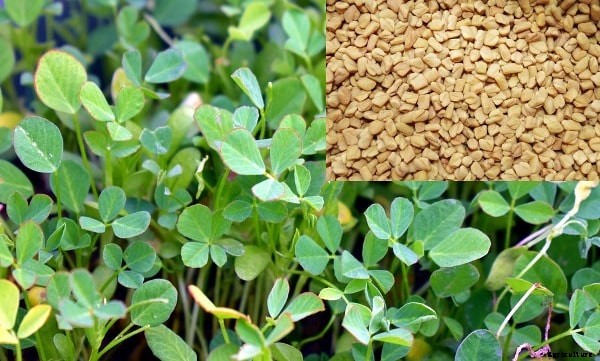 fenegriek.
fenegriek. - INVOERING: Dit kruid komt oorspronkelijk uit Oost-Europa en West-Azië. De bladeren en de zaden worden gebruikt bij de voedselbereiding. De binominale naam is Trigonella Foenum-graecum L. De maximale hoogte van het gewas is 0,9 m. Er zijn twee belangrijke variëteiten van gewassen die worden verbouwd T. Foenum-graecum (methi) en corniculata (kasuri methi).
- SOIL AND CLIMATE CONDITIONS FOR FENUGREEK SPICE FARMING: Both temperate and tropical climate are suitable for its cultivation. During seed germination temperature is being maintained around 8-27 degree Celsius. It can resist frost and extreme cold climate. Very low rainfall is required for this crop. Clayey loam is extremely good for these crops with a pH of 6-7
- PROPAGATION: Propagation is done by seeds. Seeds are soaked in warm water for 6-12 hours before sowing.
- LAND PREPARATION AND PLANTING: Ploughing is done thrice before sowing seeds and the soil beds are created uniformly with spacing between rows as 20-25 cm . In the plain area September to November is usually preferred for sowing the seeds, whereas in hilly areas the sowing is done in March.
- MANURING AND IRRIGATION: FYM @15 tonnes per hectare is used. NPK fertilizers @25 kg, 25 kg, 50 kg/ha respectively is required. Nitrogen is applied in two installments whereas the other two types of fertilizers are applied to the base of the crops at a time. 4-6 irrigation cycles are required during entire crop growth with an interval of 20-25 days between each cycle. Pre-irrigation is also done.
- DISEASE MANAGEMENT: root rot is caused by Rhizoctoni Solani and is controlled by drenching the soil with carbendazim 0.05%. Powdery mildew is controlled by spraying dinocap @20-25 grams/10 liters of water . Downy mildew is controlled by spraying 0.2% of difoltan solution.
- HARVESTING AND PROCESSING: Young shoots are removed within 25-30 days of sowing. The leaves are cut within 15 days of growth and minimum 2 cuttings are done before the flowering and fruit formation of the crop. The crops are removed when the pods dry and the entire thing is dried in the sun, which facilitates the removal of seeds by rubbing with the hands. Again the removed seeds are dried in the sun and packed.
- YIELD: One hectare of land produces 1200-1500 kg of seeds and 800-1000 kg of leaves.
ROSEMARY SPICE FARMING:
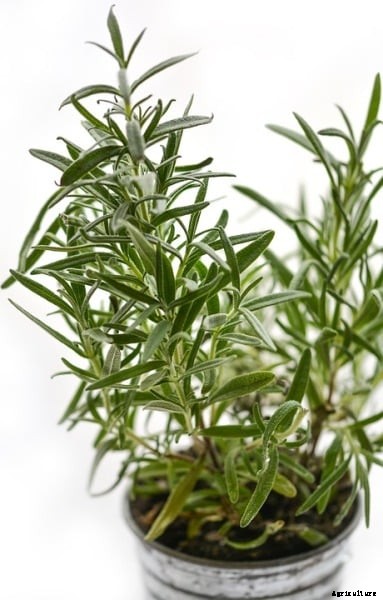 Rosemary.
Rosemary. - INTRODUCTION: Rosemary is a perennial herb and is evergreen in nature. It is a native of the Mediterranean region and its binomial name is Rosmarinus officinalis. The shrub has a maximum height of 1.5m. This crop is famous for its aroma; the leaves, twigs and flowers are used for various purposes.
- SOIL AND CLIMATE CONDITIONS FOR ROSEMARY SPICE FARMING: Well-drained lateritic soil is best for the cultivation of rosemary crops. The pH of the soil is maintained in-between 5.5-7. 20-30 degree Celsius is the ideal temperature for its growth. Average annual rainfall of 10-20 cm is required a nd an altitude of 2500 m above sea level is considered good for growing rosemary.
- PROPAGATION: Seeds are used for growing rosemary plants, but with extreme care and typical conditions. Also cuttings, roots and layering are sometimes used to grow rosemary.
- LAND PREPARATION AND PLANTING: Land to be used for cultivation is ploughed two times and neem care is mixed as a source of manure. The spacing between rows of rosemary plants have to be 40-50 cm and beds of width 1-2 m is created. Initially the cuttings are raised in the nursery and then shifted to main area during midsummer.
- MANURING AND IRRIGATION: FYM @ 50 tonnes/ha, neem cake@1 ton/ha, natural compost@ 5 tonnes/ha and vermicompost @5 tonnes /ha as applied at the base of the crop during initial planting. Subsequent year onwards 5-30 kg per hectare is applied.
- DISEASE MANAGEMENT: This shrub is resistant to pests and fungus.
- HARVESTING AND PROCESSING: When the flowering starts the plants can be harvested. From second year harvesting is done every four months. The leaves are cleaned thoroughly and dried in shade for 10-15 days .
- YIELD: one hectare of land annually produces 2.5 tonnes of dried leaves of rosemary.
CHILLIE SPICE FARMING:
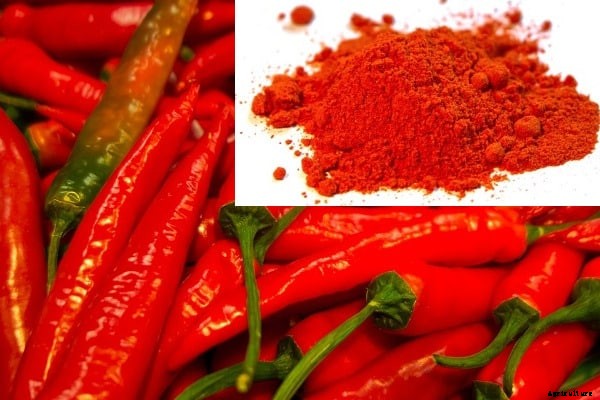 Chilli spice.
Chilli spice. - INTRODUCTION: very common and needed Indian spice is chilli. It originated from Mexico, but the largest producer of chillies Japan. It is both a spice and a vegetable variety. The binomial name of the chili is capsicum annuum. It is a shrub
- SOIL AND CLIMATE CONDITIONS FOR CHILLIE SPICE FARMING: It needs warm, humid and dry weather. Temperature ranges from 20-25 degree Celsius . Temperatures beyond 35 degree effect the fruit development. Very little moisture is required to grow chillies. Well-drained sandy loam soil having high organic content is useful for growing chillies. The pH of the soil should be in-between 5-7.5. 2100 meters above mean sea level is the altitude up to which chillies can be grown.
- PROPAGATION: chilli propagates through seeds.
- LAND PREPARATION AND PLANTING: 2-3 ploughings are given to the soil before sowing seeds. Before sowing the soil is sterilized to make it free from fungus and other infections. Seeds are initially planted in nurseries and then transplanted to the main area. Coco peat is used to cover the soil with seeds and is lightly watered until seedling stage. The crop distance is 45 cm x 45 cm in the main area. Ridges and furrows of dimensions 60 x 45 cm is maintained for intercropping. Each raised bed of chilli is dimensioned as 30 x 120 cm .
- MANURING AND IRRIGATION: These plants do not require much water. Irrigation is done only when the moisture content of water drops to less than 25%. 1 kg of azospirillum with 50 g of FYM is used as manure.
- DISEASE MANAGEMENT: White ants are treated using 8-10 aldrin/acre. Fruit rot, die back, wilt, powdery mildew, leaf spot is treated with 1% Bordeaux mixture. Neem cake @100 kg is used to destroy grubs.
- HARVESTING AND PROCESSING: Harvesting is done at regular intervals. They are dried in shade for 2-3 days.
- YIELD: One acre of land produces 30-40 quintals of fresh chillies and of which 25-35 kg of dried chillies is obtained from every 100 kg of fresh chillies.
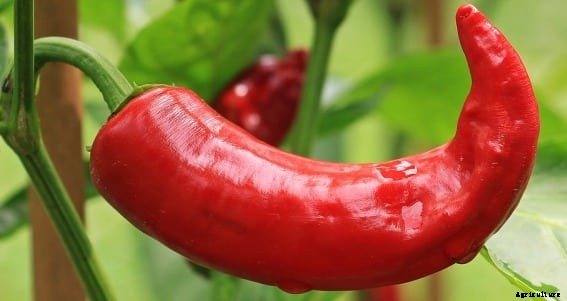 Red Chilli.
Red Chilli.
CELERY SPICE FARMING:
- INTRODUCTION: The binomial name of celery is apium graveolens. It is an herb used for various purposes. The height of the herb is 10-14 inches and has white colored flowers. It is a native of the Mediterranean region.
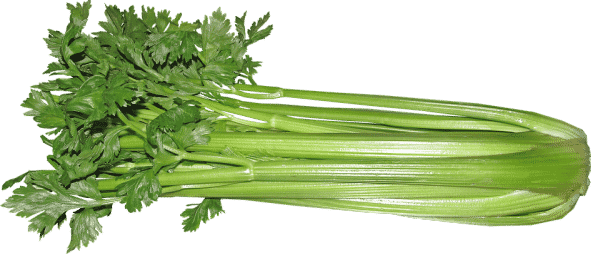 Celery.
Celery. - SOIL AND CLIMATE CONDITIONS FOR CELERY SPICE FARMING: During the growing stage it needs cold climate and during maturing it needs warm climate. A well drained loamy soil is considered good for this herb. The min temperature requirements are 12-30 degree Celsius with an average rainfall of 100 cm. The pH of the soil is maintained at 5.6 for good produce.
- PROPAGATION: propagation is done using seeds which are initially raised in a nursery and then transplanted to the main area.
- LAND PREPARATION AND PLANTING: Land is ploughed four to five times before planting. The spacing of these celery plants is 45 cm x 25 cm and the sowing depth is 2-4 cm. The seeds take 4-8 weeks for seedling and after 2 months, transplanted to the main area. November is the best time for sowing seeds.
- MANURING AND IRRIGATION: FYM @ 20-25 tonnes are used samen met nitrogen @200 kg, phosphorous @100 kg and potash @150 kg per hectare is required. Irrigation is highly essential and is given at an interval of 10-15 days.
- DISEASE MANAGEMENT: Damping –off, Fusarium yellows, early blight downy mildew is controlled by drenching the land with 400 grams of copper Oxy chloride .
- HARVESTING AND PROCESSING: 4-5 months after sowing, the crops are harvested.
- YIELD: one hectare of land yields about 25-30 tonnes of celery.
CUMIN SPICE FARMING:
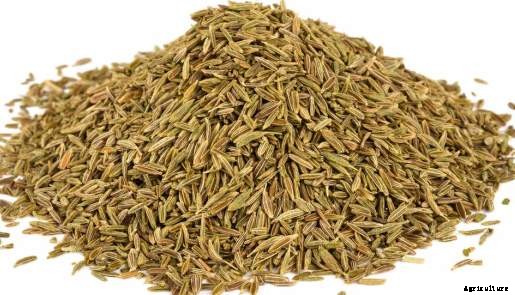 Cumin Seeds.
Cumin Seeds. - INTRODUCTION: This is a flowering plant and native to the Middle East and India. Its binomial name is Cuminium Cyminum. Cumin is a herbaceous plant whose seeds is dried and used as spice. The height of this plant is 30-50cm. In Hindi it is addressed as jeera which is most famous and widely used spice in Indian cuisines.
- SOIL AND CLIMATE CONDITIONS FOR CUMIN SPICE FARMING: Sandy loam soil with high nutrient content is required for the cultivation of cumin. The soil should be well drained and should be able to hold moisture. Mild climate is required for its cultivation and winter weather is also suitable. Sunlight is highly essential for its growth.
- PROPAGATION: seeds are used for propagation.
- LAND PREPARATION AND PLANTING: sowing of cumin seeds is done in December and the rows are spaced 30 cm apart.
- MANURING AND IRRIGATION: FYM @ 12-15 tonnes/ha samen met phosphorus @20 kg, nitrogen @30 kg is applied to the soil. These fertilizers are applied in two splits. Initially the seedlings are lightly watered and the second irrigation is done after 7-10 days.
- DISEASE MANAGEMENT: Powdery mildew is controlled by spraying 20-25 grams /10 liters of water. evenzo, Alternaria blight is controlled by spraying 0.2% of dinocap.
- HARVESTING AND PROCESSING: Complete maturity in plants is obtained within 100-115 days from sowing. Harvesting is done by uprooting the entire plant and drying it. The dried plants are thrashed to remove seeds.
- YIELD: An average yield is 5 quintals per hectare.
GINGER SPICE FARMING:
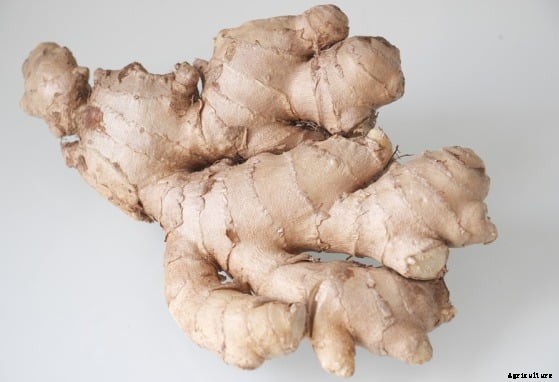 Ginger root.
Ginger root. - INTRODUCTION: This spice is native to Asia and has high demand locally and internationally. It is an herb which grows to a height of 1 m and bears yellow flowers. This spice has many medicinal properties and refreshing aroma.
- SOIL AND CLIMATE CONDITIONS FOR GINGER SPICE FARMING: Warm, humid climate is favorable for the growth of ginger. An altitude of 1400-1500 m is suitable for cultivation. This herb is grown in different soils. The pH of the soil should be 5-6.5.
- PROPAGATION: Propagation is done using rhizomes. The length of the rhizome should be 5-5 cm and should weight 20-25 grams .
- LAND PREPARATION AND PLANTING: 3-4 ploughings of land are done during summer. Crosswise harrowing is done to make the soil loose. A bed for the crops is made 1 m wide, 15 cm high . Each bed is separated by 50 cm. solarisation is done using polyethylene sheets for 40-45 days.
- MANURING AND IRRIGATION: FYM @ 15 tonnes/ha along with NPK @60 kg, 50 kg, 50 kg / ha respectively is used for growing these crops. Irrigation is provided at an interval of 8-10 days. Maximum 20 irrigation cycles are needed for the entire growing period. Drip irrigation is also preferred.
- DISEASE MANAGEMENT: Shoot borer is controlled by spraying 0.1% of Malathion. Rhizome flies are controlled by spraying 05% methyl parathion . Leaf roller and scales are controlled by spraying 0.05% dimethoate . Soft rot is controlled by captafol 0.1%. Leaf spot is controlled by a 1 % Bordeaux mixture . Root knot nematode is controlled by solarising. Bacterial wilt is controlled by spraying 200 ppm streptocycline .
- HARVESTING AND PROCESSING: Green ginger can be harvested in 215-220 days after planting the rhizomes. Yellowing of leaves indicates the harvesting season.
- YIELD: One hectare of land produces 10-15 tonnes of green ginger.
THYME SPICE FARMING:
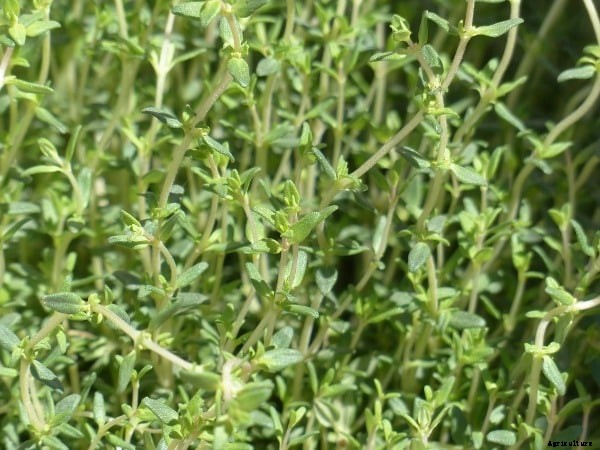 Thyme herb.
Thyme herb. - INTRODUCTION: This is an evergreen herb with aroma, generally used for cooking and medicinal purposes. It originated from the Europe and spread throughout the world through Romans.
- SOIL AND CLIMATE CONDITIONS FOR THYME SPICE FARMING: Requires well drained, vruchtbare grond. Warm climate is suited for thyme plants and hill regions are considered best for cultivation.
- PROPAGATION: It is propagated through seeds and also vegetatively by plants.
- LAND PREPARATION AND PLANTING: ploughing is highly essential to prepare the land and plants are planted 15-30 cm apart. The spacing between the rows is 60 cm.
- MANURING AND IRRIGATION: FYM @ 50 tonnes/ha, vermicompost @ 5 tonnes/ha, neem cake @1.25 kg/ha, azospirillum and phosphobacterium and panchagavya is sprayed @3%.
- DISEASE MANAGEMENT: No major diseases occur to this plant.
- HARVESTING AND PROCESSING: For cooking purposes leaves and flowers are used. Harvesting starts from 4-5 months of sowing. The shoots are cut from the plant with a length of 15 cm. When the leaves dry, they curl and turn brown.
- YIELD: one hectare of land yield 1100-2200 kg of thyme.
CLOVE SPICE FARMING:
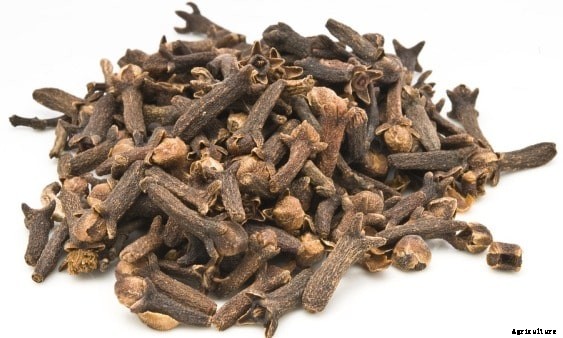 Cloves.
Cloves. - INTRODUCTION: Clove is an evergreen tree with high medicinal properties. The binomial name is Eugenia caryophyllus and is native to the Indonesian island. This plant grows to a height of 7-15 m. The dry unopened flower bud of the plant is the clove. In India the Western Ghats are popular for clove cultivation.
- SOIL AND CLIMATE CONDITIONS FOR CLOVE SPICE FARMING: This plant requires a warm, humid climate of temperature 20-30 degree Celsius and an average rainfall of 150-250 cm . The altitude is generally estimated to be 1500 m above mean sea level. Black loamy soil with rich humus is well suited for clove cultivation. Sometimes it is also grown in clay loam and laterite soil.
- PROPAGATION: Seeds are used for the propagation of clove usually during June to October. The seeds are soaked in water before sowing.
- LAND PREPARATION AND PLANTING: Pits of dimensions 60 cm x 75 cm x 3 cm are dug with a spacing of 6-7 m and filled with topsoil. Planting of seeds is done at the end of the monsoon.
- MANURING AND IRRIGATION: Rotten cattle manure @15 kg is required initially, but as the plants grow, they need more manure. The manure is applied basally at a radius of 5 m from the tree. Pot watering is required if there is no sufficient water supply. Plants need subsoil irrigation during peak summer season.
- DISEASE MANAGEMENT:
- HARVESTING AND PROCESSING: yielding starts during 7 years, but to attain full bearing the tree takes 15-20 years . After flowering the buds take 4-6 months for harvesting. The buds are dried for 4-5 days.
- YIELD: One fully grown tree gives 4-8 kg of dried buds.
FENNEL SPICE FARMING:
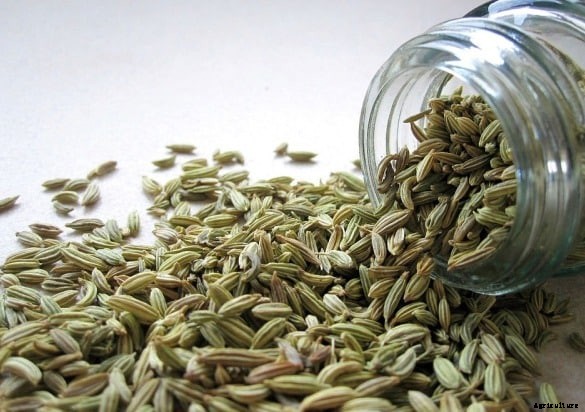 Fennel.
Fennel. - INTRODUCTION: It is a flowering plant and native to the Mediterranean. This spice has an exclusive aroma and a different flavor. This herbaceous plant grows to a height of 2.5 m. The binomial name is Foeniculum Vulgare. In India it is addressed as Saunf in Hindi.
- SOIL AND CLIMATE CONDITIONS: Every kind of soil is suitable for the cultivation of fennel. But well drained sandy or loamy soil is best suited with a pH of 6.5-8. The optimum temperature for the cultivation of these crops is 15-25 degree Celsius with an average rainfall of 50-75mm .
- PROPAGATION: It is not a transplanting variety. Propagation is done through seeds directly sowed in the main area.
- LAND PREPARATION AND PLANTING: The land is ploughed two three times to prepare a fine seed bed. This plant is rarely raised in nurseries. Sowing is done during October and if it is a rain fed region, then spacing of 45 cm between rows with 10 cm crop spacing is maintained.
- MANURING AND IRRIGATION: Cow dung@4-6qtl/acre along with urea@45 kg/acre i s applied three times in equally split proportions. Pre-sowing irrigation is done and then at an interval of 10-15 days 10-12 cycles of irrigation is required during the entire duration of cropping.
- DISEASE MANAGEMENT: Aphids are controlled by spraying 0.03% of dimethoate . Seed midge and heliothis is controlled by spraying 0.07% of endosulphan .
- HARVESTING AND PROCESSING: Maturity of plants is known when seeds are full and green in color. The umbels are cut and dried in the sun for 2 days and then dried in the shade for 10 days. The crop harvesting is done in May i.e. after 180 days from sowing.
- YIELD:O ne hectare of land yields 10-11 quintals of fennel on an average.
BLACK PEPPER SPICE FARMING:
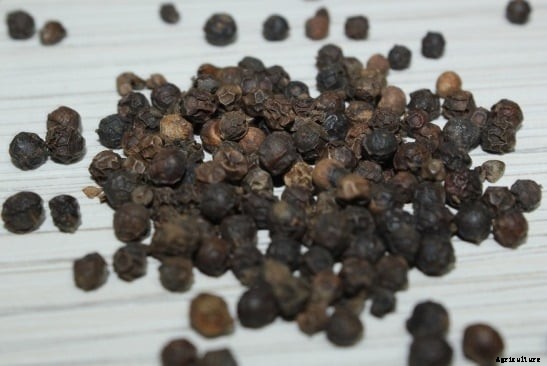 Black Pepper.
Black Pepper. - INTRODUCTION: The binomial name of black pepper is ‘piper nigrum’ and it is an evergreen flowering vine. This plant in mostly found in south India and grows to a height of 10 m. This is the earliest form of spice in India. There are 75 cultivars of pepper in India of which Karimunda is most popular. Other varieties are kottanadan, narayakkodi, aimpiriyan, kuthiravally, balancotta, kalluvally, malligesara and uddagare.
- SOIL AND CLIMATE CONDITIONS FOR BLACK PEPPER SPICE FARMING: pepper plants require tropical humid climate with sufficient rainfall (125-200 cm). The submountaeous region of Western Ghats is exclusive for growth of pepper plants. Clay loam, red loam and lateritic soils are suitable for pepper farming. The pH value of the soil is maintained at 4.5-6.0. The temperature should be in between 10-40 degree Celsius.
- PROPAGATION: Cutting from runner shoots is used for propagation of pepper. One third of the root is cut and planted in the nursery. They are obtained in the month of February –March. Roots develop from the cuttings and they are set for planting.
- LAND PREPARATION AND PLANTING: level land with proper drainage is chosen for farming. South facing slopes are avoided, but north or north eastern slopes are preferred to avoid the effect of the sun. Planting is done in the monsoon. Square pits of dimensions 0.5 m x 0.5 m are dug and the spacing between the pits is 2.5 m x 2.5 m . Seedlings which are two years old are planted in the pits. When the vine grows, it is initially made to creep on a pole of 2 m height. After a certain length the temporary stake is removed and planted in a trench of depth and width equal to 15 cm close to the tree trunk.
- MANURING AND IRRIGATION: Rotten cattle manure@ 10 kg is used as manure for pepper plants. 100 grams of nitrogen, 40 grams of P2O5 and 140 grams of K2O is used as a fertilizer for three year old plants. 1/3
rd
of the above mentioned composition is applied in the first year and 2/3rd of the quantity is applied in the second year. Lime @500 grams is applied as fertilizer during later stages of development.
- HARVESTING AND PROCESSING: Yield starts after 3 or 4 years from planting. The ripening takes 6-8 months from flowering and harvesting is done during November till February. The entire spike is plucked when the berries turn bright red. The spike is rubbed with hands to remove the berries which are then dried in the sun for 7 to 10 days until the berries turn black.
- YIELD: 800-1000 kg of black pepper is obtained from one hectare of plantation land (7-8 yrs old). The yield reduces after every 20-25 years.
CINNAMON SPICE FARMING:
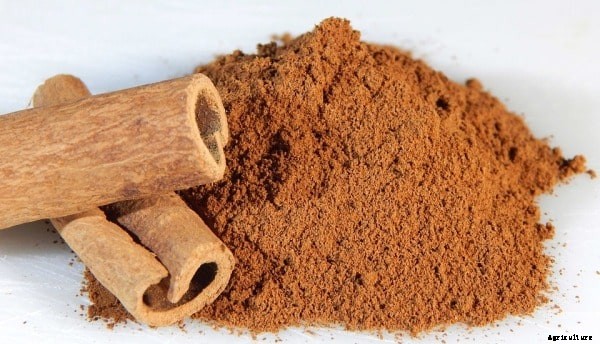 Cinnamon spice.
Cinnamon spice. - INTRODUCTION: Cinnamon is the inner bark of the tree and is the first known spice with rich flavour. It is native to Sri Lanka. Also lower slopes of Western Ghats (Kerala and Tamilnadu) cinnamon cultivation are predominant. Binomial name is Cinnamomum Cassia.
- SOIL AND CLIMATE CONDITIONS FOR CINNAMON SPICE FARMING: lateritic and sandy soil is preferred for cinnamon plant. The elevation of land above sea level is approximately 1000 m . This plant requires an annual rainfall of 200-250 cm .
- PROPAGATION :Cinnamon is propagated by rooted cuttings, air layering and seeds. 10 cm long with 2 leaves semi hardwood cuttings are dipped in keradix-B and planted in a polythene bag consisting of sand and coir dust mixture in the ratio 1:1. These are watered twice in a day and stored in the shade. After 45-60 days the roots develop indicating that it can be transplanted to a another permanent place
- A ring from the semi hardwood bark is removed and IBA 2000 ppm is applied on it. This region is covered with coir husk and wrapped with 20 cm of polythene. Rooting starts after 40-60 days and the air layers are detached from the parent plant. These can be planted in the main area during monsoon
- For the sowing of seeds a mixture of sand, soil and rotten cattle manure in the ratio 3:3:1 is prepared and germination starts after 15 -20 days. Moisture is a must for these plants.
- LAND PREPARATION AND PLANTING: Pits of dimensions 50 cm x 50 cm x 50 cm are dug with space between each pit being 3m x 3m. The pit is initially filled with topsoil and compost and the seedling are planted. One acre land can accommodate 3600 pits
- MANURING AND IRRIGATION: 20 grams of nitrogen, 18 grams of P2O5 and 25 grams of K2O are used as fertilizer in the initial growth period. The dose increases with the age of the plants. Fertilizers are applied during may-June and September-October. Green leaves are used for mulching FYM @25 kg i s applied in May-June. Irrigation is essential during summer.
- DISEASE MANAGEMENT: Colletotrichum Gloeosporioides causes leaf spotting and die back disease. Diplodia sp. causes seedling blight. Pestalotia palmarum causes grey blight. All these are controlled by a 1 % Bordeaux mixture . Pests like leaf minor and cinnamon butterfly are controlled by the use of quinalphos (0.05%).
- HARVESTING AND PROCESSING: When the tree is grown to a height of 10-15 m in 4 years, shoots are available for peeling. Coppicing is done to encourage regrowth. Shoots of thickness 5-2 cm are chosen for the extraction of barks. 1-1.25 m of shoots are cut into straight pieces followed by scraping and peeling. The peels are dried in the shade and then in sunlight for 4 days. Dried barks take the shape of a quill. Grading of quills is done from 00000, 0 being the most coarse quality. Small bark pieces are called quillings; thin inner pieces are called featherings.
- Distillation of dried cinnamon leaves and barks produces oils. This oil is used in soaps, perfumes, crèmes, toothpastes etc.
- CULTIVARS AND YIELD: Two varieties are known in India, the Navashree and the Nithyashree. 56 and 54 kg of dry quills /ha /yr are obtained from Navashree and Nithyashree respectively. The product yield of Navashree is such that 2.7% bark oil, 73% cinnamaldehyde 8% oleoresin 2.8% leaf oil, 62% leaf eugenol. The product yield of Nithyashree is (2.7% bark oil, 58% cinnamaldehyde, 10% oleoresin, 3% leaf oil and 78% eugenol.
Read about Zero Budget Natural Farming.
Read about Hydroponic Growing System.


















